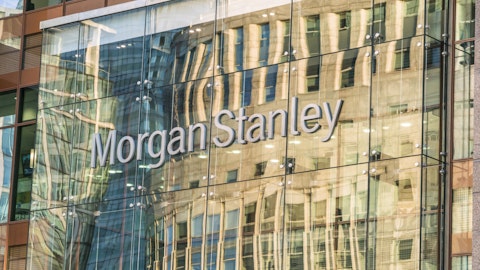Bryan Jordan: Yeah. Yeah. Our expense base at FHN Financial is very heavily tied to revenue. We have a system that is scalable costs with scalable revenue. Our team has done, I think, a fantastic job in controlling costs and even when you reach the lows in the cycle, we still make money in the business, and clearly, it’s not as profitable as it is at better or higher points in the cycle in terms of average daily revenue. But we’ve got the ability to control those costs and we will flex them, and we expect that no matter how low ADR is likely to drop in the near-term, we think we can eke out profitability even at the lowest levels and with some expectation for higher ADRs, we expect to be in a much better position through the course of 2024.
Michael Rose: Bryan, I appreciate that call. I meant holistically for the firm, not just FHN Financial.
Bryan Jordan: Oh! Okay.
Michael Rose: Sorry for if that wasn’t clear.
Bryan Jordan: No. Well, yeah, so expense levels are something that we have acknowledged that we have most control over. It’s something that we will stay focused on. We have demonstrated over a number of years the ability to control costs and take out costs out of the organization. In terms of the levers that are at hand, we think we have a number of levers. And in term, you mentioned specifically technology costs and while we’re investing in technology, we think those investments are important, particularly what I described as deferred maintenance or remedial investments from last year. There were some things that we had to get called out. So that’s a potential lever, but it’s not one I expect us to pull. Our overall cost consciousness in the effort we have in the organization I think gives us the ability to control costs as we sort of move through an environment if revenues don’t play out the way we expect.
So, again, I think that overall cost consciousness will serve us well in 2024.
Michael Rose: Appreciate the call. Thanks for taking my questions.
Bryan Jordan: No. My pleasure and sorry I misinterpreted the first time.
Operator: Our next question comes from Casey Haire from Jefferies. Casey, your line is now open.
Casey Haire: Great. Thanks. Good morning, everyone. Quick follow-up on NII, specifically the funding side of things. So, first off, is the $6 billion deposit promotion, is that fully rolled over and then what kind of deposit beta are you expecting along these four cuts?
Hope Dmuchowski: Good morning, Casey. Good to hear from you on 2024. Yes. We are fully through that repricing of the second quarter promo campaign and that 96% retention is an up-to-date number as of yesterday. So it’s not a December 31st number. It is an up-to-date number of what we’ve seen in retention on that. Through the cycle when we think about deposit rates, we really think it’s through the cycle of when do you start cutting rates and we’d probably be right around 60. If we see a May cut, we would end our beta cycle about 60. If it got later in the year, the first cut and the cycle continued, we do think that we can continue to moderate by bringing in client deposits, paying down a little bit more of a wholesale, as well as, as we mentioned in my prepared remarks, we saw a fourth quarter new-to-bank money at a significantly lower cost than we saw the prior quarter.
So we are seeing the ability to step back, not just existing money and retain it, but also bring new money in, about $1 billion in each of the last two quarters, for a lower rate than we saw in the second quarter.
Casey Haire: Got you. Okay. And just as a follow-up, trying to gauge buyback appetite, it’s — at CET1 at 11.4%, you’re comfortably above your 11% target. You do mention organic capital deployment, but it doesn’t seem like, I mean, Bryan — to Bryan’s point, loan growth sounds kind of muted. Is there — it just seems like you guys are being a little vague on the buyback, given the strength. Do we — do you manage CET1 back to that 11% level or are you going to run above that?
Bryan Jordan: Yeah, Casey. This is Bryan. We have — at this point, we don’t have an authorization with respect to share repurchases. I expect that that’s one of many things that the Board will evaluate when we work through sort of our continued outlook for the remainder of the year. And so it is one of the tools that we will consider, but ultimately, that’s a Board decision that gets made in the context of safety and soundness, outlook on the economy and so we expect to have those discussions, and again, that’s one of the levers we think that is on the table to manage that capital level.
Operator: Our next question comes from Ben Gerlinger from Citi. Ben, your line is now open.
Ben Gerlinger: Hey. Good morning.
Bryan Jordan: Good morning, Ben.
Hope Dmuchowski: Good morning.
Ben Gerlinger: I was curious if we could talk through — I know this is kind of more philosophical in nature, but the CD campaign, you obviously got a lot more money coming in than previously expected or at least kind of what the implication was. So from that, I get that there’s a retention, but how much of that is actually turning into new business, i.e., something along the line of the income line and more bringing over a relationship in general in terms of a lending opportunity?
Bryan Jordan: Yeah. In terms of the retention, the retention has been very, very good and our bankers are, I think, executing very, very well on what we’re referring to as promo-to-primacy. And while it is still early, we think we are making good progress in taking those new-to-bank relationships and broadening and expanding those relationships and that doesn’t happen instantaneously, but we see early indications that are encouraging.





